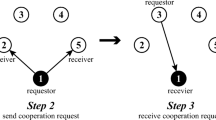Abstract
Distributed computation of average consensus is an important function in numerous wireless sensor networks and ad-hoc networks applications. In light of the severe resource constraints characterizing these embedded networked systems, it is of paramount importance the design of effective algorithms with low computational, communication, and energy requirements. Randomized gossip are a category of network algorithms that entail communication and information exchange among nodes selected with probabilistic mechanisms. They are considered attractive solutions for solving consensus problems because of their decentralized nature, conceptual simplicity, and capability of adapting to structural network modifications. However, the number of iterations needed by randomized gossip to converge towards consensus is an issue to be addressed to reduce latency and to limit the impact of the algorithm on the lifetime of battery operated devices. Solutions to the problem have been proposed that make use of localization and greedy geographic routing to build overlay graphs on top of a randomized gossip protocol, thus enabling information averaging among non-neighbor nodes and accelerating convergence. The main drawback of this type of approach is that each node is required to know its position, which is not always affordable in terms of costs or not even possible because of the lack of GPS signal. In this article we propose a novel approach to the consensus averaging problem based on a random walk mechanism to identify nodes involved in a computation round, and on a path averaging technique to update more than two nodes into the same round. The resulting algorithm doesn’t rely on any positioning mechanism. Experimental results provide evidence of the improved performance of the proposed method with respect to standard randomized gossip, with considerable gain in terms of convergence speed.






Similar content being viewed by others
References
Andersen, M. P., & Culler, D. E. (2014). System design trade-offs in a next-generation embedded wireless platform. Technical Report. UCB/EECS-2014-162, EECS Department, University of California, Berkeley. http://www.eecs.berkeley.edu/Pubs/TechRpts/2014/EECS-2014-162.html
Avin, C., & Krishnamachari, B. (2008). The power of choice in random walks: An empirical study. Computer Networks, 52(1), 44–60.
Benezit, F., Dimakis, A., Thiran, P., & Vetterli, M. (2010). Order-optimal consensus through randomized path averaging. IEEE Transactions on Information Theory, 56(10), 5150–5167.
Blondel, V., Hendrickx, J., Olshevsky, A., & Tsitsiklis, J. (2005). Convergence in multiagent coordination, consensus, and flocking. In Proceedings of 44th IEEE conference on decision and control, 2005 and 2005 European control conference. CDC-ECC ’05. (pp. 2996–3000).
Boyd, S., Ghosh, A., Prabhakar, B., & Shah, D. (2006). Randomized gossip algorithms. IEEE Transactions on Information Theory, 52(6), 2508–2530.
Denantes, P., Benezit, F., Thiran, P., & Vetterli, M. (2008). Which distributed averaging algorithm should i choose for my sensor network? In Proceedings of the 27th conference on computer communications, IEEE INFOCOM 2008.
Dimakis, A., Kar, S., Moura, J., Rabbat, M., & Scaglione, A. (2010). Gossip algorithms for distributed signal processing. Proceedings of the IEEE, 98(11), 1847–1864.
Dimakis, A., Sarwate, A., & Wainwright, M. (2008). Geographic gossip: Efficient averaging for sensor networks. IEEE Transactions on Signal Processing, 56(3), 1205–1216.
Dimakis, A. G., Sarwate, A. D., & Wainwright, M. J. (2006). Geographic Gossip: Efficient Aggregation for Sensor Networks. Proceedings of the 5th international conference on information processing in sensor networks, IPSN ’06 (pp. 69–76). ACM, New York, NY.
Freschi, V., Lattanzi, E., & Bogliolo, A. (2015). Randomized gossip with power of two choices for energy aware distributed averaging. IEEE Communications Letters, 19(8), 1410–1413.
Hendrickx, J. M., & Blondel, V. D. (2005). Convergence of linear and non-linear versions of Vicseks model. In Proceedings of 17th international symposium on mathematical theory of networks and systems (MTNS06), Kyoto (pp. 1229–1240).
Jeong, J., & Culler, D. (2012). A practical theory of micro-solar power sensor networks. ACM Transactions on Sensor Networks, 9(1), 9:1–9:36.
Li, W., Dai, H., & Zhang, Y. (2010). Location-aided fast distributed consensus in wireless networks. IEEE Transactions on Information Theory, 56(12), 6208–6227.
Moser, C., Thiele, L., Brunelli, D., & Benini, L. (2010). Adaptive power management for environmentally powered systems. IEEE Transactions on Computers, 59(4), 478–491.
Mou, S., & Cao, M. (2013). Distributed averaging using compensation. IEEE Communications Letters, 17(8), 1672–1675.
Nath, S., Ekambaram, V. N., Kumar, A., & Kumar, P. V. (2012). Theory and algorithms for hop-count-based localization with random geometric graph models of dense sensor networks. ACM Transactions on Sensor Networks, 8(4), 35:1–35:38.
Olfati-Saber, R., Fax, J., & Murray, R. (2007). Consensus and cooperation in networked multi-agent systems. Proceedings of the IEEE, 95(1), 215–233.
Sistla, K., George, A., & Todd, R. (2003). Experimental analysis of a gossip-based service for scalable, distributed failure detection and consensus. Cluster Computing, 6(3), 237–251.
Tsitsiklis, J. N. (1984). Problems in decentralized decision making and computation. Technical report, Ph.D. dissertation. Cambridge, MA: Laboratory for Information and Decision Systems, MIT.
Yick, J., Mukherjee, B., & Ghosal, D. (2008). Wireless sensor network survey. Computer Networks, 52(12), 2292–2330.
Zuniga, M., Avin, C., & Hauswirth, M. (2010). Querying dynamic wireless sensor networks with non-revisiting random walks. In J. Silva, B. Krishnamachari, & F. Boavida (Eds.), Proceedings of European conference on wireless sensor networks (Vol. 5970, pp. 49–64)., Lecture notes in computer science Berlin: Springer.
Author information
Authors and Affiliations
Corresponding author
Rights and permissions
About this article
Cite this article
Freschi, V., Lattanzi, E. & Bogliolo, A. Fast Distributed Consensus Through Path Averaging on Random Walks. Wireless Pers Commun 96, 5865–5879 (2017). https://doi.org/10.1007/s11277-017-4451-5
Published:
Issue Date:
DOI: https://doi.org/10.1007/s11277-017-4451-5




